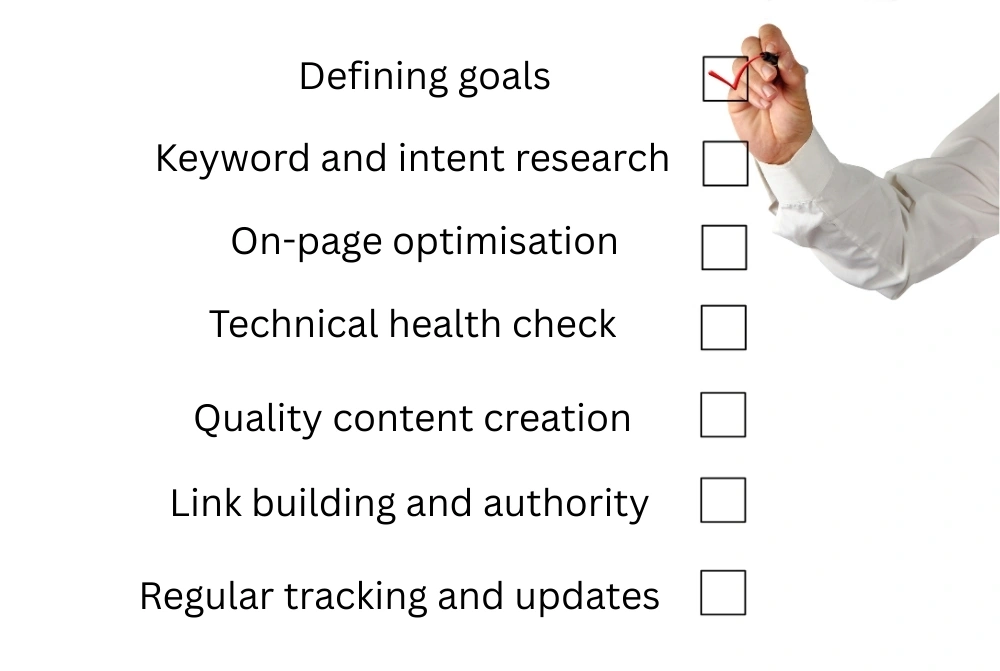TL;DR
An effective SEO strategy isn’t about chasing quick wins. It’s about aligning business goals with search, building topical authority, fixing technical gaps, and refreshing content regularly. Done right, SEO becomes a sustainable engine for growth and visibility.
Every business wants visibility, but not every business has the right plan for how to get it. That’s where an effective SEO strategy comes in.
If done right, search optimisation does far more than move you up the rankings. It connects your brand with the right people at the right moment and turns organic search into a consistent growth engine.
Yet many businesses still treat SEO as a short-term hack rather than a long-term framework. They focus on keywords alone, ignore how algorithms are evolving, or fail to align SEO with wider business goals.
We are here to help to understand that’s not it. To make a SEO strategy effective, you need to understand the basics and real-world SEO strategies that will be discussed in this blog.
The Basics of an SEO Strategy for Businesses
Before diving into the more advanced elements, it helps to understand the fundamentals. A basic SEO strategy for business often includes:
-
Defining goals: Decide whether you want to drive leads, boost sales, or improve brand visibility.
-
Keyword and intent research: Find out what your audience is searching for and why.
-
On-page optimisation: Ensure your site structure, headings, and content align with search intent.
-
Technical health check: Fix speed, crawl errors, and indexing issues that block visibility.
-
Quality content creation: Publish relevant, helpful material that showcases expertise.
-
Link building and authority: Earn mentions and backlinks from trusted sources.
-
Regular tracking and updates: Monitor KPIs and refresh content to stay competitive.
These practical SEO steps give your business a starting point. But to compete in today’s search landscape, you can’t stop at the basics.
Long term growth happens with various parameters like expanding into topical authority, adapting to AI-driven results, and implementing advanced content governance. This is also where working with a professional SEO agency can make the difference between incremental progress and transformational results.
All set to know more? Let’s begin:
1. Start With Business Goals, Not Keywords
An SEO strategy that starts with keywords is already looking in the wrong direction. An effective SEO strategy should begin with business objectives. Do you want to drive leads, increase online sales, or boost brand awareness? Each goal will shape the way you approach SEO. Defining these priorities makes sure SEO supports what really matters: growth and revenue.
Key performance indicators (KPIs) such as:
-
Conversions from organic traffic
-
Average engagement time
-
Visibility in AI-driven search features
These help measure whether the strategy is delivering results or not.
Business executives may be more interested in overall business impact, while SEO teams track more detailed metrics. What matters most is connecting the two so that everyone can see the value of search optimisation.
2. Build an Entity-First Topical Map
Modern search engines don’t just match words but also understand entities, relationships, and context. That’s why effective SEO strategy for businesses require more than targeting isolated keywords.
What’s a Topical Map? A topical map allows you to organise content around clusters of related topics and create depth and authority in your chosen areas.
For example, a business offering fitness products shouldn’t just optimise for “protein supplements.” It should build clusters around related entities like recovery nutrition, workout plans, and ingredient breakdowns. Interlinking these pages creates authority in the eyes of both users and search engines.
This approach avoids keyword cannibalisation and ensures your content stays aligned with search intent.
Looking for a professional SEO agency in India with long-term SEO strategies? Blacklisted is the name you can rely on.
3. Adapt to Changing Search Results
The importance of SEO has grown alongside changes in how results appear. Traditional “ten blue links” have been replaced by featured snippets, local packs, video carousels, and now AI-generated overviews. That means businesses must pay attention not only to rankings, but also to how they surface within these new features.
Study the live SERP (Search Engine Result Page) for each target query to learn the formats search engines like Google prioritises. You’ll find that some terms may favour video tutorials, while others highlight Q&A-style snippets. Businesses should then adapt their content formats to match these patterns.
4. Create Human-Led Content Briefs
SEO often fails when a hollow content is produced or when it is generated purely by AI. What many don’t know is that the balance lies in creating human written briefs that combine keyword research, intent mapping, and brand voice. AI content might be faster to generate, but it lacks creativity preferred by humans.
A strong content brief outlines:
-
Purpose of the content
-
Entities to cover
-
Angle to take
-
Value it should deliver
-
Proof points such as data, case studies, or expert quotes, etc.
This ensures that writers produce content that is both search-friendly and genuinely useful.
Brands working without effective digital marketing services often overlook this step, but without clear briefs, content strategies quickly lose focus.
5. Prioritise Technical SEO in 90-Day Sprints
One of the most overlooked areas in SEO strategy is technical performance. Businesses often run audits but don’t follow through with structured fixes. A practical way to approach this is by breaking technical optimisation into 90-day sprints in three phases:
-
The first phase might focus on improving page load speeds, Core Web Vitals, and image compression.
-
The second could target crawl budget efficiency, sitemap hygiene, and structured data.
-
The third phase may deal with log analysis, automation of internal linking, and faceted navigation rules.
This step-by-step approach prevents any miss-outs and ensure that technical improvements deliver measurable results.
6. Optimise for Local and Mobile Realities
Mobile optimisation might not be a bigger issue for a business operating in urban areas. But for rural areas where mobile networks aren’t always high speed, mobile-first design is not negotiable.
That means you must test on low-bandwidth devices, ensure typography is legible, speed is optimal, and simplify website layouts.
For local businesses, Google Business Profiles and local schema markup become essential tools to capture intent-driven traffic.
7. Refresh and Reuse Content Regularly
Content doesn’t stay relevant forever. Search engines prioritise pages that are updated, accurate, and valuable. That’s why content refresh cycles are crucial in any SEO strategy.
A quarterly refresh process should:
-
Evaluate traffic trends
-
Update outdated statistics
-
Merge overlapping posts
-
Replace content that no longer serves a purpose
Businesses that treat content as an evolving asset and not a one-off project can consistently maintain visibility. This should be done to show both search engines and users that your site is alive and credible.
8. Earn Authority With Digital PR
Backlinks still matter, but the way you earn them has evolved. Instead of chasing volume, brands should focus on digital PR strategies that naturally attract high-quality mentions.
Build authority by publishing original research, offering expert commentary, and building relationships with industry publications. Even unlinked brand mentions can drive recognition, influence AI-generated search results, and encourage branded searches that boost rankings.
We have worked with multiple clients to integrate SEO strategy with PR campaigns, proving that when digital marketing services overlap, the impact multiplies. Connect with us to know more.
9. Align SEO With Customer Journeys
SEO is supposed to support every stage of the customer funnel. When search optimisation is aligned with the customer journey, there is a higher probability that traffic might turn into tangible outcomes.
When you connect content to funnel stages, it makes SEO a tool for better customer experience:
-
Blog posts to raise awareness
-
Product pages to drive decisions
-
An awareness-stage blog might educate users about an industry trend
-
A comparison page helps at the decision stage
-
Post-purchase, support articles and FAQs help improve retention.
10. Establish Governance and Ownership
One of the biggest reasons SEO strategies fail is lack of ownership. Businesses often run audits, research keywords, or publish content, but without clear governance, their efforts may fail.
Assign responsibilities to your team or an external partner to keep everything moving. For growing businesses in India, working with a professional SEO agency in India ensures that expertise, tools, and execution stay aligned with long-term goals.
Final Thoughts
An effective SEO strategy includes a collective set of steps mentioned in this blog. A flexible framework that ties search optimisation to business outcomes, adapts to evolving search formats, and sustains credibility over time is the pure definition of effective SEO strategy. Businesses that invest in these strategies are the ones that build lasting growth.
While every brand’s needs are unique, one principle applies universally: SEO must be treated as a business function, not just a marketing tactic. That’s why Blacklisted continues to help companies design strategies that don’t just rank, but resonate.
Frequently Asked Questions
The first step is defining your business goals. Without clarity on whether you want leads, sales, or awareness, SEO becomes directionless.
Search engines now understand context, not just keywords. By building a topical map around related subjects, your site demonstrates depth and expertise. This creates stronger rankings and positions your brand as a credible source within an industry or niche.
A quarterly review works best. Updating statistics, merging similar pages, and retiring outdated posts keeps your content relevant. Fresh content signals credibility to both search engines and users. It also help protect hard-earned rankings against competitors producing newer material.
Technical SEO ensures your website is fast, crawlable, and user-friendly. Without a strong technical foundation, even the best content struggles to rank.
SEO involves strategy and continuous adaptation. Many businesses lack the bandwidth to manage all these effectively. Partnering with an experienced SEO agency like Blacklisted ensures your efforts stay aligned with long-term goals and deliver tangible business growth.







